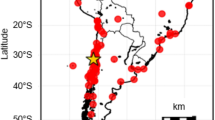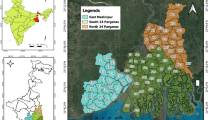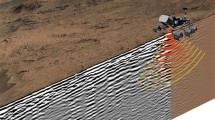Abstract
Differential synthetic aperture radar interferometry (DInSAR) is a space-geodetic technique which allows minute surface displacements over vast areas to be detected with centimetric accuracy. Because of these unique characteristics, the DInSAR approach has great advantages over classical geodetic monitoring systems that allow the anticipation of high-risk situations. In the past few decades, it has been successfully applied in many areas of the earth and environmental sciences. However, there have been very few applications of this approach to active open pit mines in tropical environments. In this work, the DInSAR technique was applied to detect and monitor unknown surface displacements that may be occurring in the N4W iron mine, northern Brazil. X-band data acquired from March 2012 to April 2013 during the TerraSAR-X satellite mission were utilized for this purpose. The results were checked in the field and compared to optical leveling data. Due to the consistent deformation pattern observed over a mine waste pile, Pile W, we also performed numerical modeling in order to carry out a preliminary assessment of its theoretical deformation behavior. The results show that most of the study area can be considered to be stable. The numerical modeling indicated that horizontal displacements may be occurring, and that the DInSAR technique can be used to provide an initial rapid assessment of a large-scale deformation field, which could prove to be very useful, particularly in large active mining areas.















Similar content being viewed by others
Notes
The coherence measures the degree of decorrelation between complex radar scenes. Decorrelation refers to the degree to which the surface changes physically and electrically over time.
There currently is no clear threshold for defining a cut slope in the N4 iron mines as unstable. It is known that many factors influence its stability. According to Ryan and Call (1992), there are situations where even tiny displacements can be considered hazardous. Deformation rates of up to a few centimeters per week have been reported for the N4 iron mines.
References
Amelung F, Galloway DL, Bell JW, Zebker HA, Laczniak RJ (1999) Sensing the ups and downs of Las Vegas: InSAR reveals structural control of land subsidence and aquifer-system deformation. Geology 27(6):483–486
Bamler R, Hartl P (1998) Synthetic aperture radar interferometry. Inverse Prob 14:R1–R54
Beisiegel VR, Bernardelli AL, Drummond NF, Ruff AW, Tremaine JW (1973) Geologia e recursos minerais da Serra dos Carajás. Revista Brasileira de Geociências 3(4):215–242
Bieniawski ZT (1989) Engineering rock mass classifications: a complete manual for engineers and geologists in mining, civil and petroleum engineering. Wiley, New York, p 272
Brasileiro Instituto do Meio Ambiente e dos Recursos Naturais Renováveis (IBAMA) (2004) Plano de Manejo para Uso Múltiplo da Floresta Nacional de Carajás. IBAMA, Brasília
BVP Engenharia LTDA (2011) Mapeamento Litoestrutural e Litogeomecânico da Mina N4WN; Relatório Interno-VL 070-10-E-CA-RT-03-55-00. BVP Engenharia LTDA, Belo Horizonte, p 75
Carnec C, Massonnet D, King C (1996) Two examples of the use of SAR interferometry on displacement fields of small spatial extent. Geophys Res Lett 23(24):3579–3582
Chatterjee RS, Syafiudin FM, Abidin HZ (2013) Land subsidence characteristics in Bandung City, Indonesia as revealed by spaceborne geodetic techniques and hydrogeological observations. Photogrammetric Eng Rem Sens 79(7):639–652
Colesanti C, Wasowski J (2006) Investigating landslides with space-borne synthetic aperture radar (SAR) interferometry. Eng Geol 88:173–199
Colesanti C, Ferretti A, Prati C, Rocca F (2001) Comparing GPS, optical leveling and permanent scatterers. In: Proc IGARSS’01, Sydney, Australia, 9–13 July 2001, pp 2622–2624
Costa JBS, Pinheiro RVL, João X Da, Araújo OJB (1991) Esboço estrutural do Proterozóico médio da Amazônia Oriental. Boletim do Museu Paraense Emílio Goeldi 3:9–24
Costa JBS, Araujo JB, Santos A, Jorge Joao XS, Macambira MJB, Lafon JM (1995) A província mineral de Carajás: aspectos tectono-estruturais, estratigráficos e geocronológicos. Boletim Museu Paraense Emílio Goeldi, Série Ciências da Terra 7:199–235
Costantini M (1998) A novel phase unwrapping method based on network programming. IEEE Trans Geosci Rem Sens 36(3):813–821
Dall’Agnol R, Costi HT, Leite AAS, Magalhaes MS, Teixeira NP (1999) Rapakivi granites from Brazil and adjacent areas. Precambr Res 95(1–2):9–39
Derauw D, Moxhet J (1996) Multiple images SAR interferometry. In: Proc Fringe 96 Workshop on ERS SAR Interferometry, Zurich, Switzerland, 30 Sept–2 Oct 1996, pp 167–178
Dixon T (1995) SAR interferometry and surface change detection. Technical report TR 95-003:97. University of Miami, Miami. http://southport.jpl.nasa.gov/scienceapps/dixon/, accessed 18 July 2013
DOCEGEO (1988) Revisão litoestratigráfica da Província Mineral de Carajás. Proceedings of the Congresso Brasileiro de Geologia, 35, 1988. Província Mineral de Carajás—litoestratigrafia e principais depósitos minerais. Anexo aos anais. CVRD-SBG, Belém, pp 11–54
Farina P, Colombo D, Fumagalli A, Marks F, Moretti S (2006) Permanent scatterers for landslide investigations: outcomes from the ESA-SLAM project. Eng Geol 88:200–217
Gabriel AK, Goldstein RM, Zebker HA (1989) Mapping small elevation changes over large areas: differential radar interferometry. J Geophys Res 94(B7):9183–9191
Goldstein RM, Werner CL (1998) Radar interferogram filtering for geophysical applications. Geophys Res Lett 25(21):4035–4038
Graham LC (1974) Synthetic interferometer radar for topographic mapping. Proc IEEE 62:763–768
Grainger CJ, David IG, Tallarico FHB, Fletcher IR (2008) Metallogenesis of the Carajás Mineral Province, southern Amazon Craton, Brazil: varying styles of Archean through Paleoproterozoic to Neoproterozoic base- and precious-metal mineralization. Ore Geol Rev 33:451–489
Hartwig ME, Paradella WR, Mura JC (2013) Detection and monitoring of surface motions in active open pit iron mine in the Amazon region, using persistent scatterer interferometry with TerraSAR-X satellite data. Rem Sens J 5:4719–4734
Instituto Brasileiro de Mineração (IBRAM) (2011) Informações e análises da economia mineral brasileira. 6° Edição. IBRAM, Brasília
Kimura H, Yamaguchi Y (2000) Detection of landslide areas using satellite radar interferometry. Photogrammetric Eng Rem Sens 66:337–344
Klees R, Massonnet D (1999) Deformation measurements using SAR interferometry: potential and limitations. Geol Mijnbouw 77:161–176
Madsen SN, Zebker HA (1998) Imaging radar interferometry. In: Henderson FM, Lewis AJ (eds) Principles and applications of imaging radar—manual of remote sensing, vol 2, 3rd edn. Wiley, Danvers, pp 359–380
Massonnet D, Feigl K (1995) Discrimination of geophysical phenomena in satellite radar interferograms. Geophys Res Lett 22(12):1537–1540
Massonnet D, Feigl KL (1998) Radar interferometry and its application to changes in the Earth’s surface. Rev Geophys 36(4):441–500
Massonnet D, Rossi M, Carmona C, Adragna F, Peltzer G, Fiegl K, Rabaute T (1993) The displacement field of the Landers earthquake mapping by radar interferometry. Nature 364:138–142
Orman M, Peevers R, Sample K (2011) Waste piles and dumps. In: Darling P (ed) SME mining engineering handbook, 3rd edn. SME, Denver, 1:667–680
Paradella WR, Cheng P (2013) Using Geoeye-1 stereo data in mining application: automatic DEM generation. Geoinformatics 16:10–12
Pinheiro RVL, Holdsworth RE (1997) The structure of the Carajás N-4 ironstone deposit and associated rocks: relationship to Archean strike-slip tectonics and basement reactivation in Amazon region, Brazil. J South Am Earth Sci 10(3-4):305–319
Prati C, Ferretti A, Perissin D (2010) Recent advances on surface ground deformation measurement by means of repeated space-borne SAR observations. J Geodyn 49:161–170
Rocscience (2011) Rocscience software products: Phase2—finite element analysis for excavations and slopes, v.8.0. Rocscience, Inc., Toronto
Rott H, Nagler T (2006) The contribution of radar interferometry to the assessment of landslide hazards. Adv Space Res 37:710–719
Ryan TM, Call RD (1992) Applications of rock mass monitoring for stability assessment of pit slope failure. In: Tillerson JR, Wawersik WR (eds) Rock Mechanics: Proc 33rd US Symp, Santa Fe, NM, USA, 3–5 June 1992, pp 221–229
Sá G, Soares F, Pires MHA (2008) Condicionantes de ruptura na mina de N4WN, Carajás-PA. In: 12° Congresso Brasileiro De Geologia De Engenharia E Ambiental, Porto de Galinhas, Brazil, 23–27 Nov 2008
Sabater JR, Duro J, Arnaud A, Albiol D, Koudogbo FN (2011) Comparative analyses of multi-frequency PSI ground deformation measurements. Proc SPIE 8179:81790M
Strozzi TG, Bitelli G, Wegmuller U (2000) Differential SAR interferometry for land subsidence mapping in Bologna. In: Proc Sixth Int Symp on Land Subsidence—SISOLS 2000, Ravenna, Italy, 24–29 Sept 2000, 2:187–192
Strozzi T, Wegmüller U, Tosi L, Bitelli G, Spreckels V (2001) Land subsidence monitoring with differential SAR interferometry. Photogrammetric Eng Rem Sens 67(11):1261–1270
Strozzi T, Farina P, Corsini A, Ambrosi C, Thuring M, Zilger J, Wiesmann A, Wegmuller U, Werner C (2005) Survey and monitoring of landslide displacements by means of L-band satellite SAR interferometry. Landslide 2(3):193–201
Tassinari CCGE, Macambira MJB (1999) Geochronological provinces of the Amazonian Craton. Episodes 22(3):174–182
Wasowski J, Bovenga F (2014) Investigating landslides and unstable slopes with satellite multi temporal interferometry: current issues and future perspectives. Eng Geol 174:103–138
Werner C, Wegmuller U, Strozzi T, Wiesmann A (2000) Gamma SAR and interferometric processing software. In: Proc ERS-ENVISAT Symp, Gothenburg, Sweden, 16–20 October 2000
Zebker HA, Villasenor J (1992) Decorrelation in interferometric radar echoes. IEEE Trans Geosci Rem Sen 30:950–959
Zebker HA, Rosen PA, Goldstein RM, Gabriel A, Werner CL (1994) On the derivation of coseismic displacement fields using differential radar interferometry: the Landers earthquake. J Geophys Res Solid Earth 99(B10):19617–19634
Zienkiewicz OC, Taylor RL, Zhu JZ (2013) The finite element method: its basis and fundamentals, 7th edn. Butterworth–Heinemann, Oxford
Acknowledgments
This research was developed under the scope of the Project FAPESP-Vale-INPE (grant #2010/51267-9), which the first author would like to thank for his Ph.D. scholarship (grant #2011/23068-4, São Paulo Research Foundation—FAPESP). The author would also like to thank the Vale S.A. mining company for providing geological and optical leveling data and for supporting the field work. The author is grateful to Dr. Maurício Galo and Paulo de Oliveira Camargo (UNESP-Presidente Prudente, Brazil) for his helpful suggestions on the geometrical treatment of the optical leveling data. The author thanks the Civil Engineer Carlos Henrique Doretto (GeoCompany Tec., Engenharia e Meio Ambiente LTDA, Brazil) for allowing him to use the Phase2 software license and for helpful information about numerical simulation. Finally, the author would like to express his sincere thanks to the reviewers of the manuscript.
Author information
Authors and Affiliations
Corresponding author
Ethics declarations
Conflict of interest
The authors declare no conflict of interest.
Rights and permissions
About this article
Cite this article
Hartwig, M.E. Detection of mine slope motions in Brazil as revealed by satellite radar interferograms. Bull Eng Geol Environ 75, 605–621 (2016). https://doi.org/10.1007/s10064-015-0832-8
Received:
Accepted:
Published:
Issue Date:
DOI: https://doi.org/10.1007/s10064-015-0832-8




